Menu
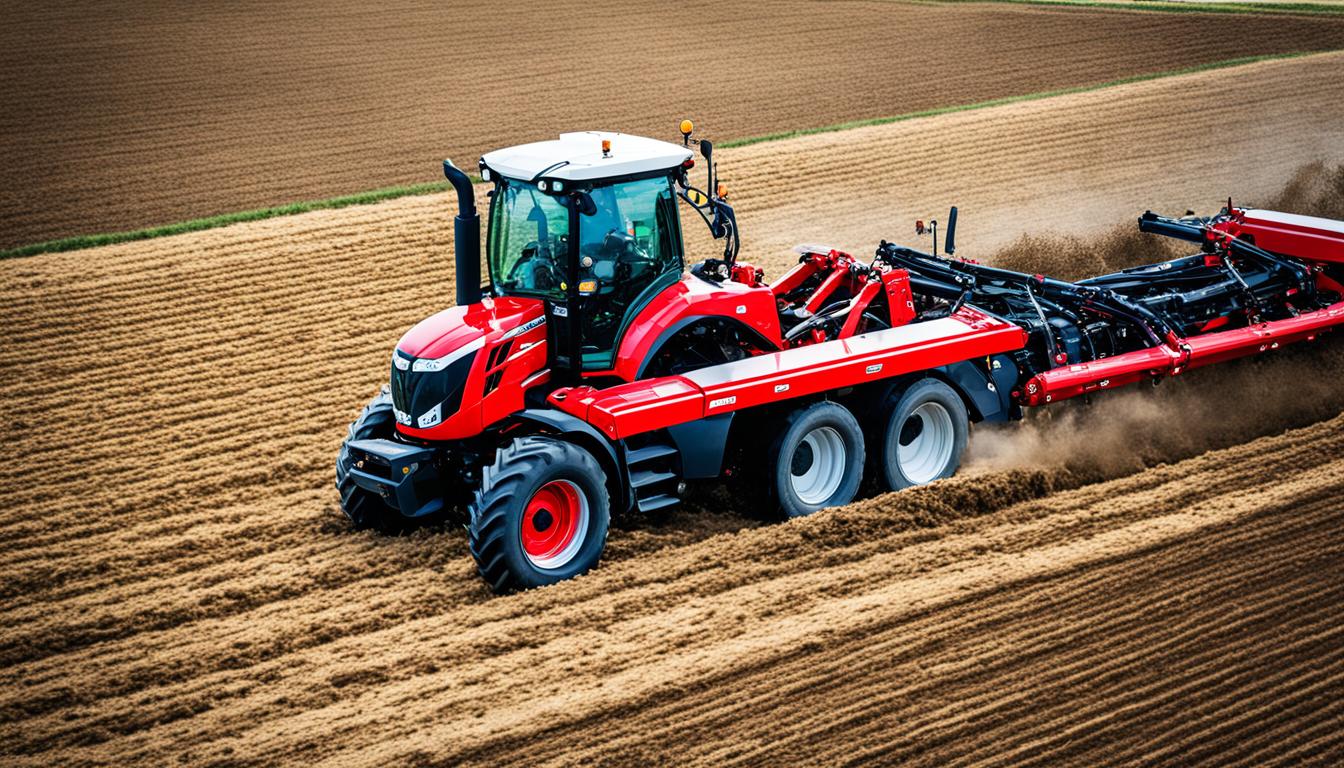
Can top-notch farm equipment really change farming safety? Looking into advanced tractor safety tech, we see a big shift. Now, the industry is moving away from old, simple tools to high-tech machinery.
Tractors have come a long way from being just petrol-driven to what they are today. They now have cool features like being able to drive themselves, use GPS, and think with the help of AI. Such progress makes farming much safer and more effective than before. It’s important to note that before these changes, tractor accidents were a big problem, causing about 44% of farm deaths. This added up to about 130 lives lost per year. But, thanks to tech like self-driving tractors and smart data analysis, these risks have gone down a lot.
For example, electric tractors, like the Monarch MK-V, are doing wonders for health and safety. They cut out the need for farmers to breathe in diesel fumes. This lessens the chances of getting sick with diseases like lung cancer. Also, smart safety systems in farm machinery can avoid crashes. This helps save the equipment and the plants being grown.
These new steps aren’t just about making things less risky. They’re also about using resources better and farming in a way that keeps the earth healthy. Exploring these changes shows us how farm safety is improving. This leads to farming that’s not just safer but more productive, too.
Find out more about how these new safety features in farming equipment are making agriculture safer in the future here.
Tractor safety has come a long way to reduce risks in farming. Technologies like Rollover Protective Structures (ROPS) play a big part. They help prevent accidents, especially tractor rollovers, which cause around 130 deaths each year.
Most tractor falls happen when getting on or off incorrectly. This can be made safer with better steps and handrails. Power Take-Off (PTO) dangers highlight the need for shields to be secure.
Many dangers on farms are related to the machinery itself. These include things like wrap points, hydraulic systems, and crush points. It’s up to users to check guards, keep clear of moving parts, and stay safe around the PTO.
Driving tractors on roads needs certain precautions. This includes good lights, careful attachment securing, and avoiding weak road edges. ROPS law means newer tractors protect against rollovers, greatly reducing deaths.
Knowing how tractors tip over is key. For example, a tractor’s speed greatly impacts centrifugal force. Four-wheel-drive tractors are less likely to tip over than two-wheel-drive ones, as their weight is better spread out.
Agricultural deaths globally are high, especially in countries like Europe, the US, and Korea. Still, places like Italy face more risks due to older tractors without safety features. For small farms, updating machinery is a big cost.
Data and digital tech make tractors safer too. They offer info on how machines are working, aiding maintenance and avoiding accidents. This way, farming not only gets better but also safer over time.
The story of tractor safety is a fascinating journey. It’s been shaped by both old breakthroughs and new discoveries. We explore how past milestones and today’s cutting-edge features make the farm a safer place.
The journey to safety in farming began slowly. First, there were innovative engines. In 1849, Robert Ransome patented the first movable steam engine. This invention changed farming into a mechanised process.
By 1917, Henry Ford’s Fordson Model F made owning a tractor possible for many. Tractors like the Fordson and John Deere’s Model D from the 1920s-1940s were iconic. They not only boosted productivity but also made farming safer. In the mid-20th century, diesel tractors became the norm. They were more efficient, had more power, and lasted longer.
From the 1950s to the 1980s, tractors became more versatile and safer. They started using hydraulic systems and power take-offs. Roll-over protective structures (ROPS) were added, protecting operators if the tractor rolled over.
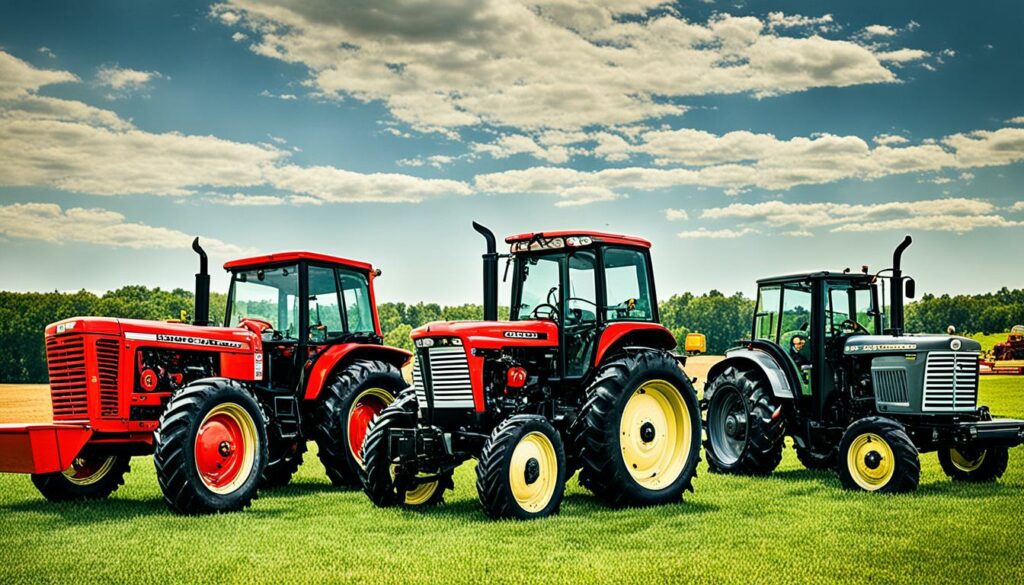
Rollovers cause more than half of all tractor deaths. However, adding ROPS could prevent around 1,000 deaths in the next ten years. It would cost about $2.5 billion to do so.
Today’s tractor safety is all about high-tech solutions. Tractors using GPS increase crop yields. Autonomous tractors are the latest technology in farming. They can cut costs, work more efficiently, and lower the risk of accidents.
Now, tractors are getting even smarter with digital and artificial intelligence. They come with systems that monitor things in real-time and avoid collisions. Valtra’s SmartTouch is a great example of this new level of tractor safety.
It’s said that autonomous tractors could stop 250 deaths each year in the U.S. But, these new tractors raise concerns about jobs, safety, and cyber risks.
Tractor cabs have also seen big improvements. They’re designed for less operator tiredness. Now, they have better visibility, air conditioning, soundproofing, and digital controls.
Let’s compare safety from the old tractors to new ones:
| Period | Key Innovations | Safety Improvements |
|---|---|---|
| Early 20th Century | Diesel Engines, Portable Steam Engines | Increased efficiency, introduction of mechanisation |
| Mid-20th Century | Hydraulic Systems, Power Take-Offs | Versatility, operator safety enhancements |
| Recent Decades | GPS Technology, Autonomous Tractors | Precision farming, reduced accidents, enhanced efficiency |
The jump from old tractor safety ideas to new ones is huge. It shows a constant effort to keep farmers safe and improve how farming works.
Autonomous tractors bring a new level of safety and efficiency to farms with their state-of-the-art autonomous safety systems for agricultural vehicles. They work without humans, making farm work safer. The Monarch MK-V, launched in December 2022, is the first of its kind. It can do its job with or without a driver, which is perfect for medium-sized farms. These tractors can work around the clock, boosting what a farm can do.
The AI systems in these tractors are key to enhancing farm operations. They’re great at seeing and avoiding things, which prevents crashes. The MK-V, for example, can sense everything around it. This means it can move safely across different parts of a farm. And just one person can watch over many tractors. This is super helpful when there’s not enough people to work the farm.
These tractors rely on top-notch GPS and lots of sensors. Basic GPS has about a 7.0-meter accuracy most of the time. This lets the tractors move precisely across the farm. With companies like Bluewhite, any tractor can get a smart upgrade. This makes going autonomous not too expensive for farmers. Now, tasks like spraying and mowing don’t need as much manual work. This makes farms both safer and more efficient.
Autonomous tractors also help farms become more eco-friendly. By using resources better and making less waste, they support organic farming. In the U.S., farmers of crops like wine grapes are using technology for better results. These precise methods lead to more crops and less waste, which is good for the environment.
GPS guidance systems in agriculture and sensor technologies bring big changes to farming. They make things more precise, cost-effective, and easy for farmers. These tools are key in modern agriculture.
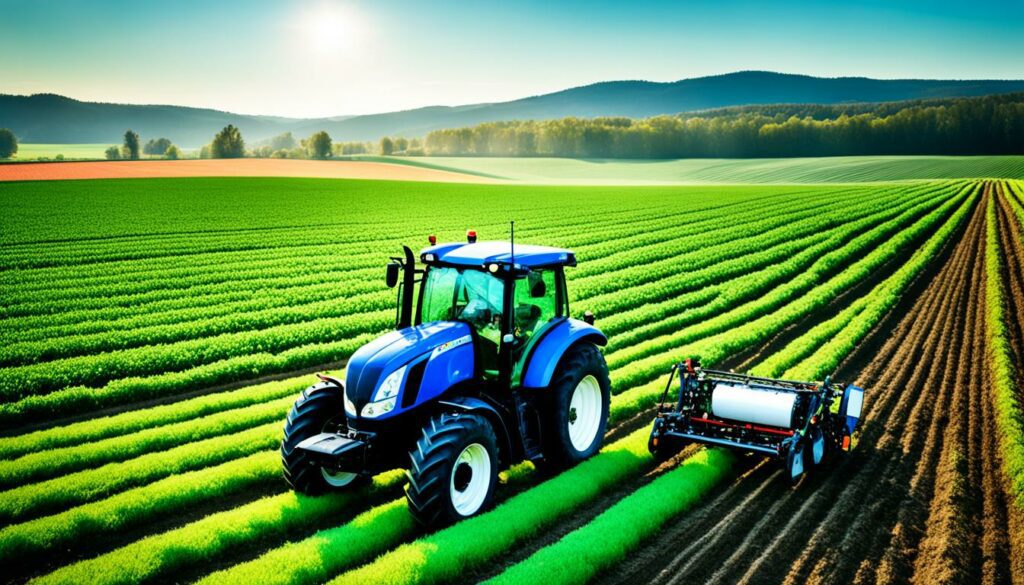
GPS is crucial for outlining fields, roads, and watering systems accurately. It lets farmers spot issues in their crops for focused action. With GPS, crop advisors can map out areas with pests, insects, or weeds. They then make targeted plans to improve crop health and yield.
GPS also helps aircraft sprayers apply chemicals accurately. They can treat only the needed areas, cutting chemical use and helping the environment.
Sensors are vital for live monitoring and feedback, boosting farm safety and running. When linked with GPS, they can pick up changes in the environment fast. This means quick adjustments can be made.
Real-time monitoring helps farmers check on tractor health, crop status, and environmental conditions. It keeps farms safe and efficient. With the U.S. adding more GPS signals, GPS tools in farming are set to get even better. They are the future of farming.
Electric farm vehicles are changing how we farm. They are part of a move to more eco-friendly farming. They don’t produce harmful exhausts like diesel ones do. This makes the air farmers breathe cleaner, reducing the chances of diseases.
Their design also helps prevent accidents. They use smart tech to cut down on dangers like getting caught in machines or overturned tractors. Jeff Jurgens from the Association of Equipment Manufacturers says they keep workers safer.
Going electric can save a lot of money too. For example, the Monarch Tractor MK-V saves loads on fuel. In the first year alone, it saved more than $198,000. Plus, they have less parts to break, so maintenance is cheaper.
The electric tractor market is growing fast. It will jump from being worth USD 0.7 billion in 2024 to USD 3.4 billion by 2030. This is partly thanks to money-saving deals and grants, especially in places like California.
By switching to electric, farms can be safer and make more money. As rules on emissions become stricter, using these types of vehicles makes more sense. It’s also easier on the pocket as they require less maintenance and can be powered by the sun or wind.
Electric tractors are quick to respond and offer better control. This is great for jobs that need fast, accurate work. Tools like Monarch Tractor’s system make farming easier and safer too.
Choosing electric on the farm means choosing a better future. It shows the big impact new tech can have on the world of farming. It makes farming safer, cleaner, and more profitable for everyone.
Robotics and AI are leading a major change in tractor safety. By using digital tools, agricultural vehicles are more secure. They are making tractors work better with less risk.
AI in farming vehicles is great at spotting obstacles. With GPS that’s mostly accurate within 7.0 meters, vehicles like Monarch Tractor’s MK-V stay safe as they move. AI uses sensor data instantly to steer clear of obstacles, stopping accidents and getting work done smoothly.
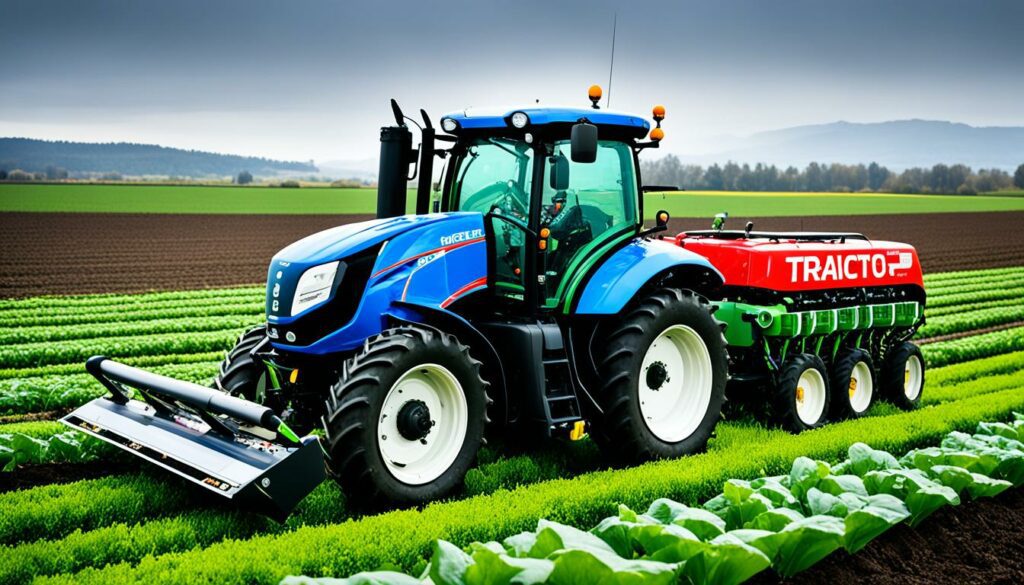
Tractors now come with robotic arms for precise work like planting and harvesting. These arms are really accurate. They make farming safer and improve the quality of the crops by cutting down on mistakes.
AI-powered vehicles are getting better at doing lots of farm jobs on their own. This makes farms more productive and eco-friendly.
Here’s a table comparing Monarch Tractor’s MK-V with its impact on the industry:
| Feature | Monarch Tractor MK-V | Industry Impact |
|---|---|---|
| Electric, Driver-Optional | Yes | First fully electric, driver-optional tractor, promoting sustainable farming |
| Precision GPS | Utilises basic GPS for 7.0-meter accuracy | Enhanced safety and navigation accuracy |
| AI-Driven Obstacle Detection | Yes, with 360º situational awareness | Minimises collisions and improves operational efficiency |
| Robotic Arms | Integrated | Offers precise handling of farm tasks, enhancing product quality |
| Environmental Sustainability | Supports organic and sustainable practices | Reduces waste and conserves resources |
The MK-V is a front-runner in showing how digital solutions and AI can make farming smarter, safer, and better for the planet.
Tractor rollovers remain a significant risk in farming. Rollover Protective Structures (ROPS) play a key role in keeping farm workers safe. Around 20 out of every 100,000 American farmers die on the job each year. This makes ROPS and other safety measures extremely important. With 4.8 million tractors in the U.S., half of them do not have proper rollover protection.
ROPS and seat belts are crucial in preventing deaths from tractor rollovers. They are about 99% effective in keeping people safe. It is worrying that tractor overturns are the main cause of farm worker deaths in the U.S. Notably, 1,412 workers died in rollovers from 1992 to 2005.
The NIOSH states that fitting all tractors with ROPS could lower fatality rates by 71%. However, not all tractors, even new ones, have ROPS. Many new tractors are sold with ROPS but have them removed later.
Experience doesn’t always protect against rollovers, showing that everyone is at risk. And if there’s a fatal rollover, 7 out of 10 farms could close within five years. Luckily, more farmers are using ROPS. The usage has increased from 38% in 1993 to 59% in 2006, thanks to stricter rules and greater awareness.
Adding ROPS to old tractors is cost-effective, at around $1000. Despite this, not enough farmers are doing it. This situation calls for more incentives and awareness to promote ROPS use. It’s important to regularly check and keep up ROPS to ensure they work when needed.
| Region | Percentage of Tractors with ROPS | Fatal Overturn Rate |
|---|---|---|
| South and West | 52% | Moderate |
| Midwest | 46% | Moderate |
| Northeast | 40% | High |
Focusing on preventing tractor rollovers is crucial for farm safety. This includes using and adding more ROPS. As farming techniques get safer, ROPS will continue to be a key player in reducing risks and saving lives.
Tractor cabs have greatly improved over the years. They’re designed to help the operator see better and be more comfortable. Manufacturers started making big changes in the late 1970s. Since then, safety and comfort for farmers have been key.
Designing comfortable tractor cabs has cut down on how tired operators get. This has boosted how much work gets done. Valmet led the way with cabs that had good heating from the 60s to the late 70s. By the 1980s, cabs grew larger to be even more comfortable.
Today’s cabs have features like suspension systems and controls within easy reach. They keep getting better every year.
Valtra’s 4th generation T Series, released in 2014, was a game-changer. It made safety and comfort top priorities. This model quickly became a hit for its smart design. Then, in 2017, the SmartTouch interface set a new standard for ease of use.

Seeing clearly and easy-to-use controls are crucial on a farm. Cab designs aim to give farmers a clear look at their work. They also make it simple to operate the tractor.
Starting in the 1980s, better heating, air condition, and noise reduction became common. This made cabs more pleasant places to work.
Landini introduced category 4 cabins that are super safe. So safe, they’re airtight with special filters. This protects farmers from harmful dust and chemicals when working in orchards and vineyards.
From 2006, new laws in Europe have made cabins safer. They require thorough testing to ensure farmers are well-protected. These rules show the ongoing effort to make farm work safer and comfier.
Precision agriculture is changing how farms work, making them safer and more efficient. New safety technologies are key to reducing risks and looking after farm workers.
Turning over is a big danger for tractors, causing nearly half of all farm accidents. These accidents take about 130 lives each year according to OSHA. Technologies like Monarch’s Smart 4-wheel Drive stop tractors from flipping, saving lives.
Modern tractors are also getting smarter with eyes. Tractors like the Monarch MK-V can see and avoid hitting people or objects. This stops damage to expensive tools and crops, making farms safer.
Electric tractors are making farm workspaces healthier. They don’t use diesel, which means cleaner air for farm workers. Monarch’s electric tractors are leading the way by being kinder to people’s health and the environment.
Using machines that drive themselves is making farms even safer. These automatic systems keep people away from dangerous jobs. They use GPS to drive straighter, meaning fewer mistakes and safer work.
Many farms are already using guidance systems, which helped make planting more accurate between 2010 and 2013. VRT and GPS soil mapping, although less common, have made big improvements too. Back in 2010, VRT made 1% more profit for corn farms, while GPS mapping saw profits up nearly 3%.
In conclusion, advanced farm technologies are making agriculture safer and more efficient. This progress in tractor safety and operation highlights the big steps the farming world is making.
In today’s agriculture, the use of agricultural data analytics and digital farming solutions marks a new era. These tools offer deep insights into how tractors work and crop health. By giving farmers real-time data, issues like machine problems and pests can be quickly dealt with, keeping farms productive and safe.
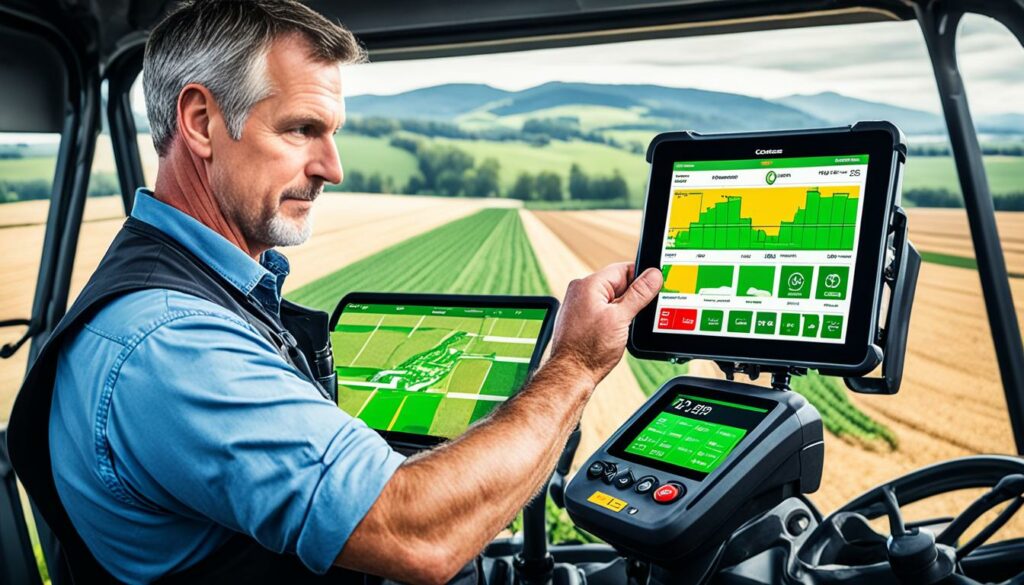
Monarch Tractor leads with its electric tractors that use Stereolabs’ AI and ZED 2i cameras. These cameras help spot obstacles and recognise gestures, making farming safer and cheaper. With high-definition camera technology and precise GPS, operations get down to a 2 cm accuracy, boosting farm tasks’ efficiency.
This gathered data offers important strategies for farmers, helping them mix modern methods with better profits and eco-friendliness. Syngenta, with its Digital Data Capture (DDC) tech, stands out. They use drones with top cameras to take super high-quality images of fields, offering key data. The tech also checks on weather, soil, pests, and diseases in farm test areas.
Farmers now use precision farming techniques, relying on digital farming solutions and data to tackle big issues like the climate crisis. Methods including no or low tillage, storing carbon in soil, and planting cover crops are more common. This approach uses real-time land data for smart actions on watering, fertilising, and protecting crops.
Syngenta’s big investment in regenerative agriculture proves its strong push for better, eco-friendlier farming. With the help of agricultural data analytics and digital farming solutions, farming’s safety and production are set to reach new heights. This ensures a bright future for farming, supporting the planet.
| Technologies | Benefits |
|---|---|
| Monarch Tractor’s AI and Cameras | Enhanced Safety and Cost Reduction |
| Stereolabs and GPS Integration | Precision Level to 2 cm Accuracy |
| Syngenta’s DDC Technology | Comprehensive Data Insights and Environmental Monitoring |
Sustainability is changing how tractors keep us safe. By adding green technologies, we’re making farms safer and Eco-friendlier. This means farm work is getting better for everyone.
One big step is making tractors run on biofuels. This cuts down on the bad stuff in the air. It also means our farms are healthier places to be. Emission controls help tractors run cleaner too.
Together, these ideas fight climate change. They’re part of a worldwide effort to make our planet better.
Farms are getting smart about where they put chemicals. GPS and special sensors let tractors spray just the right spots. This means less chemicals are needed.
Fewer chemicals mean less harm to the earth and people working the farms. It’s also about using our resources better. Tractors and farming are becoming friendlier to our planet.
The progression of vehicle safety innovations has boosted the protection and reliability of farm equipment. The use of advanced farm equipment protection systems is vital in current farming methods. It keeps belongings safe from theft and misuse.
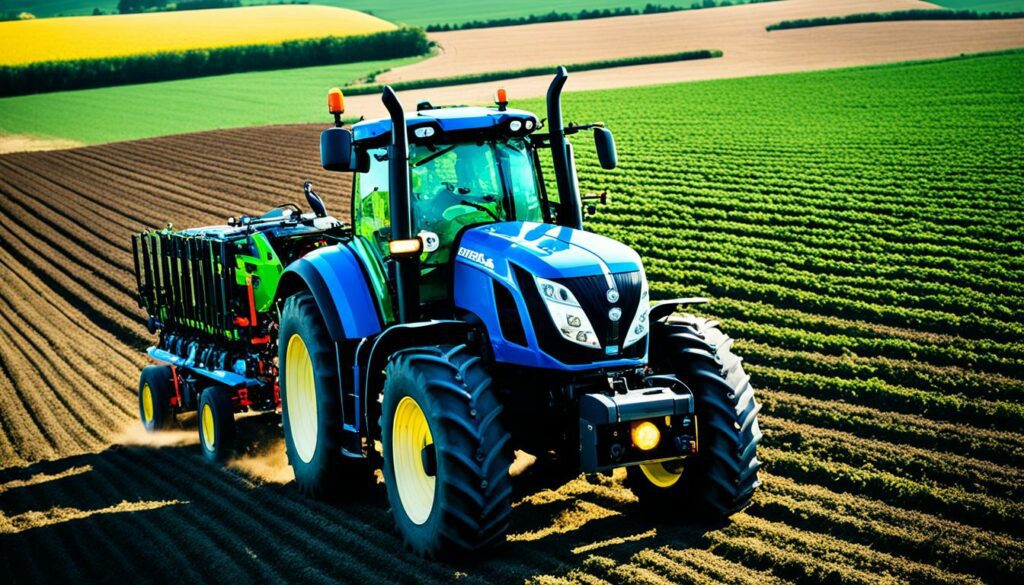
Remote checking is now a top technology for farm managers. It lets them watch over their gear from afar. With GPS, system quickly shows where the machinery is. It makes sure they stay in their work zones. This cuts the chance of theft and encourages safe use.
“In 2018, 25 percent of all workplace deaths in Wisconsin occurred in the agriculture, forestry, fishing, or hunting industries, highlighting the high risk associated with these sectors.”
Adding geofencing to security systems is another big step. This tech sets up digital borders for the machinery. If something goes beyond these borders, a quick alert goes out. This is very useful on big farms where manual checks are hard.
New tractors also come with smart sensors and alarms. They can notice if someone is trying to use it without permission, or if there’s a serious trouble. This quickly warns the driver and farm overseers. It helps cut down on work stoppages and accidents. This meets with the aim to lower injuries on farms set by the National Institute for Occupational Safety and Health.
| Safety Technology | Features | Benefits |
|---|---|---|
| Remote Monitoring | Real-time location tracking | Enhanced security, quick response to theft |
| GPS Tracking | Accurate location data | Operational efficiency, reduced recovery time |
| Geofencing | Virtual operational boundaries | Prevention of unauthorised use and theft |
| Advanced Sensors | Anomaly detection | Immediate alerts for safety, reduces risks |
The blend of vehicle safety innovations and high-level farm equipment security systems has totally changed farming. It has made work much safer. By using the latest tech, farmers can protect their gear and improve overall safety.
Safety on farms is crucial. It means knowing what causes tractor accidents. The National Institute for Occupational Safety and Health (NIOSH) says tractor accidents are the top cause of farmer death. These accidents often involve rollovers, runovers, collisions, and getting caught in parts. We’ll look at why these happen and what can be done to stop them, making farms safer.
OSHA points out that tractor rollovers are a big issue. Also, older tractors without key safety features are more dangerous. Problems with equipment can come from not looking after it properly, factory faults, or just being used a lot. Bad weather like fog, rain, snow, and ice makes accidents more likely.
Using tractor accident prevention measures cuts down on risks a lot. It’s really important to have Rollover Protective Structures (ROPS) on tractors. They protect drivers in rollovers. Teaching everyone about safety through training and campaigns makes a big difference. New technology, like self-driving systems, helps prevent mistakes too.
Other key things to do are to always wear seatbelts, not load tractors too much, and avoid bad ground. It’s vital to keep hands and feet safe from the moving parts and to attach tools safely. Also, everyone should wear the right protective gear, such as helmets and gloves. Good hitching practices, comfy seats, and regular checks on the tractor help a lot with safety.
Looking into the future, it’s clear that tractor safety is crucial. We’re seeing big changes with autonomous systems, electric vehicles, and robots. These changes will make farming better and safer for those who work the land. This shift is vital for keeping agriculture both sustainable and secure.
The safety improvement in recent years is worth noting. There’s been progress thanks to initiatives like the OECD’s 2020 standard codes for testing tractors. Also, studies in Italy and Spain have pointed out what needs to get better. This focus is because accidents like tractor rollovers cause too many deaths. New safety rules and tech like ROPS are helping save lives.
Switching to electric and AI-powered machines will bring more safety and eco-friendliness. These advances will support a farming future that’s both safe and productive. It shows our industry is moving towards more safety and less harm to our planet. This aims to protect those working in farming while ensuring we can feed the world for years to come.
Tractors use advanced safety tech like autonomous systems and AI for spotting obstacles. They also have Rollover Protective Structures (ROPS) and GPS. These improve accuracy and lower the chances of accidents.
The latest farm machinery has ergonomic cabins and better visibility controls. It uses real-time data to keep things safe and efficient. Autonomous features help keep operators from dangerous spots.
In the past, we saw diesel engines for more power, Rollover Protective Structures for safety, and GPS for better navigation. These have all cut down on accidents and made tractors work better.
Autonomous tractors use AI and sensors to find obstacles and avoid them. This means they can run without human operators. GPS systems help them navigate well, making operations safer and more efficient.
GPS and sensors help tractor move accurately and prevent overlap. They check the tractor’s health and the field’s conditions in real time. This makes agricultural work safer and more efficient.
Electric tractors don’t emit gases and are quiet, making work safer. They’re as powerful as diesel ones but without polluting. So, they keep safety high while helping the environment.
AI and robotics make tractors find and avoid obstacles better. They can work alone with great precision. This cuts down on mistakes, making products better and workers safer.
Rollover Protective Structures (ROPS) are key in protecting operators if tractors roll over. They meet top safety standards, keeping operators safe from serious harm.
New cabin designs make work easier and reduce accidents by making operators see better. They’re designed to cut tiredness, helping operators do their jobs better and safer.
Safety tech in tractors makes farm work more precise, lowering errors. GPS, sensors, and AI make tasks like planting more exact. This boosts safety and work quality.
Digital tools and data give real-time info on tractor health and field work. Farmers can spot and fix issues fast, keeping work safe and productive.
To be green, tractors are becoming biofuel-friendly and have better ways to control emissions. They also use fewer chemicals, protecting both nature and workers.
Now, there are remote monitoring, GPS tracking, and security systems for farm tools. These stop theft and make sure equipment is safe and looked after.
Key steps to avoid accidents are using Rollover Protective Structures, training, and raising awareness. Autonomous tech is also great at reducing dangers around tractors.